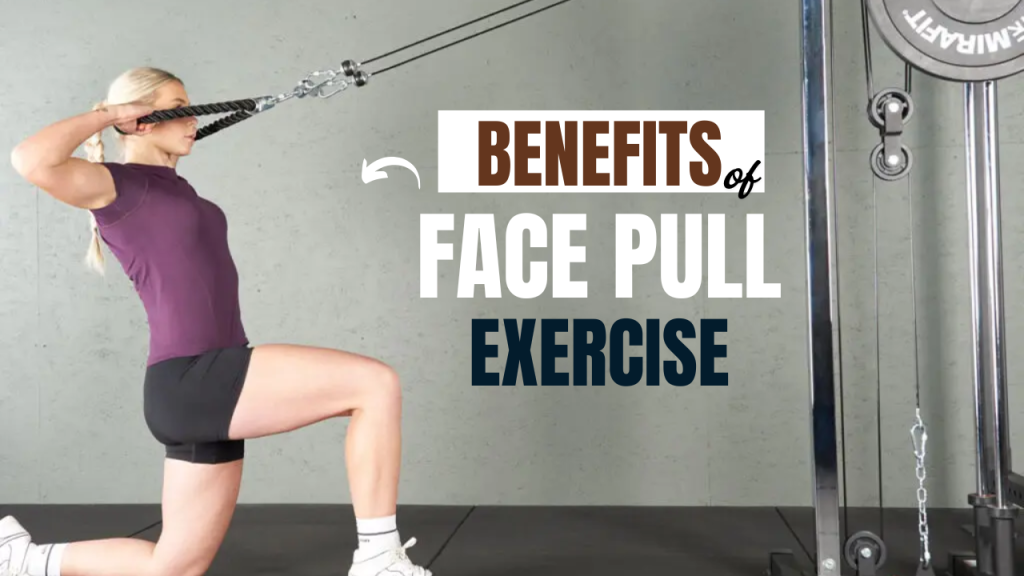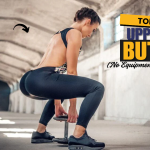“Fix your posture, sculpt your shoulders, and prevent injuries — all with one underrated movement.”
That’s the power of the face pull. While flashy gym moves like the bench press or deadlift get all the attention, the face pull quietly builds the foundations of a strong, pain-free upper body. Whether you’re a fitness rookie or an experienced lifter, this simple cable or band exercise offers game-changing benefits — especially for those glued to desks or battling poor posture.
Below, we’ll break down the top 10 face pull exercise benefits, and by the end, you’ll know exactly why this should be a non-negotiable in your weekly routine.

1. Improves Shoulder Health and Stability
Face pulls directly target the rear deltoids, rotator cuff muscles, and scapular stabilizers, which are often undertrained. Strengthening these muscles promotes shoulder joint stability, reducing the risk of rotator cuff injuries — especially important for athletes and anyone lifting overhead regularly.
2. Corrects Poor Posture (Especially from Desk Jobs)
Slouched shoulders and forward head posture are the results of modern sedentary lifestyles. Face pulls reverse this by activating the rhomboids, traps, and posterior deltoids, pulling the shoulders back into alignment. Over time, this encourages a natural upright posture.
3. Builds a Strong Upper Back
A balanced physique isn’t just about the front. Face pulls emphasize the upper and mid-back muscles, helping to create that 3D look while supporting overall upper body strength. A strong upper back also plays a vital role in compound lifts like squats and deadlifts.
4. Enhances Shoulder Mobility
By working through a full range of motion with proper form, face pulls help improve flexibility and mobility in the shoulders. This is essential for athletes, weightlifters, and functional fitness enthusiasts who want optimal joint health and performance.
5. Reduces Risk of Imbalances and Injury
Overtraining the chest and front delts without balancing out the rear leads to muscular imbalances. Face pulls counteract this by rebalancing muscle development, which can prevent nagging shoulder pain and long-term damage.
6. Supports Better Bench Press Performance
Believe it or not, pulling helps pushing. A stronger upper back and more stable shoulders translate to better control and power in the bench press. Face pulls can enhance your pressing strength by providing a solid base and preventing “shoulder cave-in.”
7. Improves Scapular Retraction and Control
Scapular control is a fundamental component of shoulder mechanics. Face pulls train you to retract and stabilize your scapula, which is crucial in every upper body movement — from rows and presses to overhead lifts.
8. Enhances Athletic Performance
For athletes in sports requiring throwing, punching, or swinging (e.g., baseball, boxing, golf), face pulls reinforce the muscles involved in these motions. The result is greater shoulder power, stability, and injury prevention — all key for peak performance.
9. Ideal for Warm-Up or Rehab
Because face pulls use light to moderate resistance and emphasize control, they’re perfect as a pre-workout warm-up or post-injury rehab tool. They activate essential muscles without overloading the joints, making them safe for nearly all fitness levels.
10. Supports Aesthetic Shoulder Development
Let’s not forget the vanity factor — face pulls round out shoulder aesthetics by developing the often-neglected rear delts. If you want that capped-shoulder look from every angle, you need more than just presses — face pulls complete the visual package.
Bonus Tip: Why You Shouldn’t Skip Face Pulls
Most people skip face pulls because they’re not a “heavy” lift. But think of them as insurance for your shoulders. In fact, top strength coaches like Jeff Cavaliere and Eric Cressey recommend face pulls to virtually every client — from pro athletes to office workers — because they build resilience, structure, and performance.
Face Pull Execution Tips (So You Actually See Results)
- Use a rope attachment or resistance band
- Set the pulley at the upper chest or eye level
- Pull toward your face (not neck or chest)
- Keep elbows high and wide
- Pause at peak contraction
- Start with light resistance, focus on control
What to Expect After 30 Days of Face Pulls
| Benefit | Result After 30 Days |
|---|---|
| Posture Improvement | Noticeably better shoulder alignment; reduced slouching especially if working a desk job. |
| Rear Delt Activation | Increased mind-muscle connection and visible toning of the rear shoulders. |
| Upper Back Strength | Enhanced muscle endurance in traps, rhomboids, and scapula stabilizers. |
| Reduced Shoulder Discomfort | Decreased nagging pain due to improved rotator cuff and shoulder stability. |
| Better Scapular Control | Improved ability to retract and stabilize shoulder blades during lifts. |
| Enhanced Lifting Technique | More stability in compound lifts like bench press, overhead press, and rows. |
| Muscle Imbalance Correction | Noticeable balance between front and back delts; improved upper body symmetry. |
| Injury Prevention | Lower risk of shoulder impingement and rotator cuff strain. |
| Athletic Performance | Better shoulder mobility and coordination in sports or functional movements. |
| Confidence Boost | Upright posture and stronger upper body leads to improved physical appearance and self-confidence. |
Conclusion: Add Face Pulls to Your Routine Today
Face pulls may not be the flashiest exercise in your program, but their benefits are hard to ignore. From injury prevention and posture correction to performance gains and muscle aesthetics, this one move covers a lot of ground. Start incorporating 3 sets of 12–15 reps into your training at least twice a week — your shoulders and upper back will thank you.
Frequently Asked Questions (FAQs)
What muscles do face pulls target?
Face pulls primarily target the rear deltoids, rhomboids, trapezius (especially the lower and middle traps), rotator cuff muscles, and other scapular stabilizers. These muscles are essential for posture, shoulder stability, and overall upper back development.
Are face pulls good for posture?
Yes, face pulls are excellent for posture correction. They strengthen the muscles responsible for pulling your shoulders back and keeping your spine in alignment, making them ideal for people with rounded shoulders or forward head posture from long hours of sitting.
How often should I do face pulls?
For most people, 2–3 times per week is ideal. You can include them on upper body or pull days, or use them as a warm-up before pressing workouts. Aim for 3 sets of 12–15 reps using light to moderate weight with perfect form.
Can beginners do face pulls?
Absolutely! Face pulls are beginner-friendly, especially when done with resistance bands. They’re low-impact and easy to learn, making them a great starting point for improving shoulder strength and mobility.
Are face pulls bad for shoulders?
Not at all — when done correctly, face pulls are one of the safest and most shoulder-friendly exercises. They help prevent injuries by strengthening stabilizing muscles. However, improper form (e.g., pulling too low or using too much weight) can reduce effectiveness or strain the shoulder.
Can face pulls help shoulder pain?
Yes, especially if your shoulder pain is due to muscle imbalances or poor posture. Face pulls strengthen neglected muscles and improve joint alignment. However, consult a healthcare provider if the pain is due to injury or inflammation.
Can I replace other shoulder exercises with face pulls?
Face pulls shouldn’t replace pressing or overhead movements but should complement them. Think of face pulls as a balancing movement that ensures all areas of your shoulders develop evenly — especially the often-neglected rear delts and upper back.





